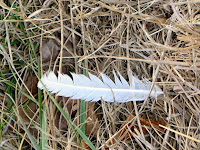Nevertheless, the concept of "home" can genuinely touch deep resonances within us if it is skillfully used by a poet. The very word "home" can express a place of belonging we'd like to get back to, even if we've never quite been there. Some of the best instances I've encountered of the use of "home" also speak to a relationship with Nature.
One poem that makes an explicit correlation (and which seems to portray an actual event in the poet's life) is written by Joseph Bruchac. The poem has the unusual title of "Geese Flying over a Prison Sweat Lodge." A session together in a sweat lodge (similar to a sauna) is one Native-American way of bonding socially and re-grounding spiritually. In the incident this particular poem describes, however, being in the comforting interior space of the lodge ("inside our memories / waiting to be born again") is contrasted with the imprisoning walls of prison life ("mortared stone / with razor wire on top"). Paradoxically, once enclosed within the set of walls of the sweat lodge, the prisoners find release through a contact with Nature they cannot even see. That is because they hear "the cries of the geese... their touch deep as bone, / speaking words never written / That always mean home."
The "home" metaphor can be powerful (if deftly used) because it speaks not only to our inner resonances with the natural world but also to our loneliness and our fear of separation. I know of no better expression of the two elements together -- Nature and longing -- than in the following short poem by Rainer Maria Rilke. Interestingly, Rilke, like Bruchac, draws upon migrating birds' astounding homing instinct -- their urge to get home.
"Ah, not to be cut off,
not through the slightest partition
shut out from the law of the stars.
The inner – what is it?
if not intensified sky,
hurled through with the birds and deep
with the winds of homecoming."
~~~
Do you have a way of getting back home spiritually?
(The Bruchac poem can be found in
Native American Songs and Poems, ed. Brian Swann, © 1996.)
(The Rilke poem, trans. by Stephen Mitchell, is from
Ahead of All Parting: The Selected Poetry and Prose of Rainer Maria Rilke, © 1995.)




























![Li Bai [Li Po] Chanting a Poem", by Liang K'ai (1140 - c. 1210)](https://blogger.googleusercontent.com/img/b/R29vZ2xl/AVvXsEhpfCAqxW5_SPeDVmmpWWckAD8WW69wCYM-Lo35DaMtQqn8xVJeh0lp8q0fFh0ucUWEPZKDzRBdO0UOwtPzNCvLcZRtajN1LMQAYpLeeqlJ37yrnqTH5ZyiI1gPyK-qt3keySunjacN_8M/s200/Li+Po.jpg)









